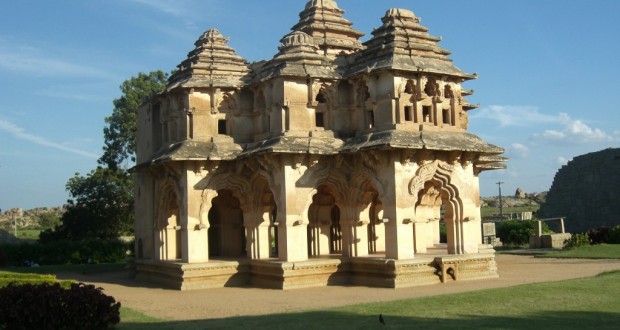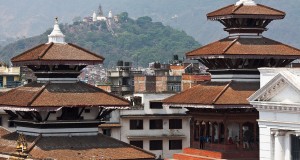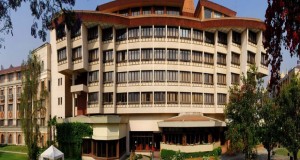About 190 km (119 miles) east of Belgaum and 350 km (219 miles) north of Bangalore lie the ruins of Hampi, once the greatest of all medieval Hindu capitals. Founded in 1336 by two local princes, Hari Hara and Bukka, it became the seat of the mighty Vijayanagar empire, which held sway over south India for more than two centuries. By 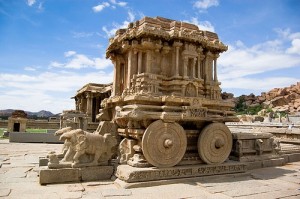 the reign of Krishnadeva Raya (1509-29), generally considered the golden period of the empire, its rule extended from the Arabian Sea to the Bay of Bengal, and from the Deccan plateau to the tip of the peninsula. The Vijayanagar kings built up Hampi as a showpiece of imperial magnificence, and a definitive Vijayanagar style of I architecture emerged, typified by lofty gopurams, stylised sculptures (often depicting scenes from the Puranas and the Ramnyana), intricately carved columns, and separate shrines for goddesses.The city itself had a spectacular natural setting, enclosed on three sides by the Tungabhadra river and by rocky gorges.
the reign of Krishnadeva Raya (1509-29), generally considered the golden period of the empire, its rule extended from the Arabian Sea to the Bay of Bengal, and from the Deccan plateau to the tip of the peninsula. The Vijayanagar kings built up Hampi as a showpiece of imperial magnificence, and a definitive Vijayanagar style of I architecture emerged, typified by lofty gopurams, stylised sculptures (often depicting scenes from the Puranas and the Ramnyana), intricately carved columns, and separate shrines for goddesses.The city itself had a spectacular natural setting, enclosed on three sides by the Tungabhadra river and by rocky gorges.
The addition of seven concentric rings of massive fortifications made it almost invulnerable to attack. Hampi had a series of enlightened rulers who patronised the arts and education, cultivating it as a centre of learning and culture. Meanwhile, a growing trade in spices turned its busy, colourful bazaars into an international centre of commerce. In its heyday, the city had a population of half a million, bolstered by a powerful mercenary army of one million soldiers. Such a large force was required to defend the supremacy of Vijayanagar against rival Muslim sultans and Hindu kings. In 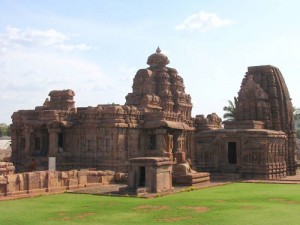 1565, however, it was finally overcome by five allied Deccan sultans in the disastrous battle of Talikota. The king fled southwards, and the invaders spent six long months systematically sacking and looting the abandoned city, burning and pillaging without mercy. The empire lingered on for another century, but Hampi itself was never occupied again.Hampi’s ruins are well worth the 2-day side trip from Bangalore. So well preserved are the relics, and so vividly do they reflect a vanquished past, that Hampi has been termed ‘The Pompeii of India’. Spread over a vast area of 26 sq km, including temples, pavilions, baths and palaces, the ruins are on a very grand scale. You can really sense a mighty civilisation at work here; with only the slightest effort of imagination, you can really visualise it. At present, the Government of Karnataka and the Archaeological Survey of India are trying to restore the capital to something of its past glory. An ambitious project perhaps, but not impossible. A great many of the ruins are in surprisingly good condition.
1565, however, it was finally overcome by five allied Deccan sultans in the disastrous battle of Talikota. The king fled southwards, and the invaders spent six long months systematically sacking and looting the abandoned city, burning and pillaging without mercy. The empire lingered on for another century, but Hampi itself was never occupied again.Hampi’s ruins are well worth the 2-day side trip from Bangalore. So well preserved are the relics, and so vividly do they reflect a vanquished past, that Hampi has been termed ‘The Pompeii of India’. Spread over a vast area of 26 sq km, including temples, pavilions, baths and palaces, the ruins are on a very grand scale. You can really sense a mighty civilisation at work here; with only the slightest effort of imagination, you can really visualise it. At present, the Government of Karnataka and the Archaeological Survey of India are trying to restore the capital to something of its past glory. An ambitious project perhaps, but not impossible. A great many of the ruins are in surprisingly good condition.
Hampi has a very dry, exposed location and is best visited in the cool months of December to February. Travellers do trickle in as early as August and September, when the river is swollen by the monsoon and the surrounding countryside a rich lush green, and as late as March, but after that it’s too hot for comfort.
ARRIVAL/DEPARTURE
Hampi can be reached within a day from both Bangalore and Hyderabad.
Rail
From both cities there is one overnight train daily taking 8 and 13 hours respectively. From Bangalore the Hampi Express overnight train leaves at 9.30 pm and reaches Hospet at 6.20 am the following morning. The return departs Hospet at 9 pm and reaches Bangalore at 8 am. From Hyderabad you have to change trains at Guntakal.
Road
There are 10 express buses daily from Bangalore (9 hours) and 2 from and to Hyderabad(11-12 hours). Two buses a day to Mysore (10 1/2 hours), and a few morning buses to Hubli, for Goa (4/5 hours). Hubli has one express bus to Panjim (dep 11 am, arr 3 pm), four slow buses to Panjirn (7 hours), and one slow bus to Vasco (7/8 hours). There are also 2 trains (dep 7 am and 11 pm) from Hubli to Goa.
Hospet to Hampi 13 km (8 miles)
Road
A regular local bus service connects these two places. Otherwise, hire an auto-rickshaw, taxi, or bicycle.

